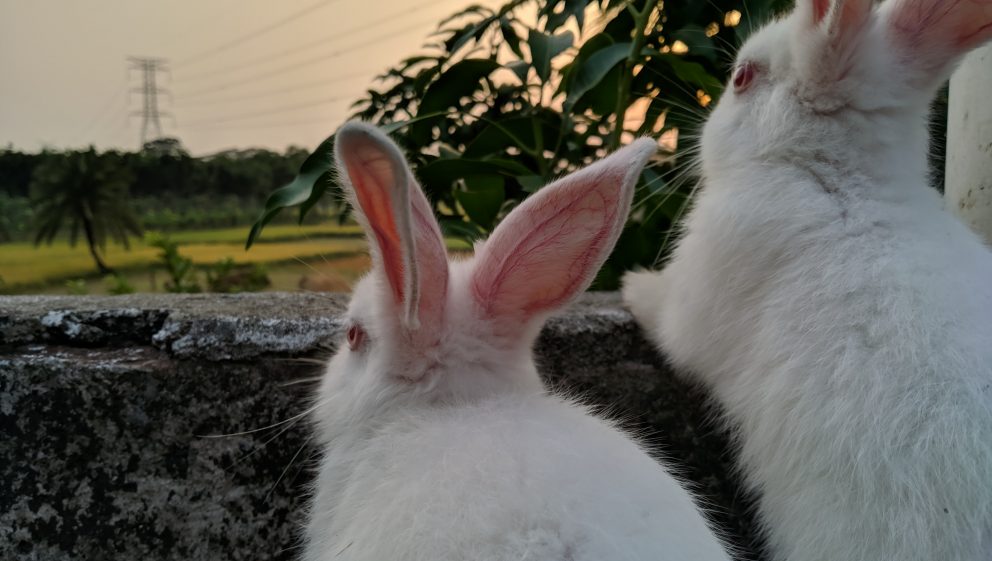Ban on the use of lead shot – finally!
Posted 10 Jul 2025

Posted on the 26th February 2021
Help stop a rabbit meat and fur farm gaining permission to set up in Cornwall.
The determination deadline for this application has now passed, but objections are still being registered. Please send an objection today, if you haven't already.

Update: The proposal was refused in March 2021 and a later appeal also dismissed.
An application has been put forward by Phil Kerry of T&S Nurseries, a rabbit farm ‘franchiser’, to get planning permission granted for the set-up of a 250 female rabbit breeding and rearing operation to produce upwards of 10,000 rabbits per year. They previously created public outrage by trying to set up rabbit battery cage farming systems across the UK. It is clear that the motivation is certainly not animal welfare.
The deadline is 12th March.
Petitions are good to show a strength of feeling against a proposal but do not carry so much weight in the planning decision process as individual objections. Objections to proposals made directly to the Council carry the most weight in planning.
You can also object via email. Send your objection to planning@cornwall.gov.uk
Include the Planning Application Number: PA20/08566
| Land North Of Tregunwith Wood Tregunwith Mylor Bridge TR11 5SU |
And also your full name and postal address in order for it to be valid.
Please feel free to elaborate upon the following bullet points in your objection. Remember that, unfortunately, moral objections or animal welfare do not hold weight in planning objections, but that doesn’t mean that you shouldn’t voice your thoughts in passing.
It is also an opportunity to ask for welfare to be made a material consideration during review of planning permission applications involving animals.
Public attitudes to rabbit meat and real fur
– We understand that fur would likely be produced as a ‘by-product’ which is highly distasteful and ‘fur farming by the back door’ : http://www.tandsrabbits.co.uk/products.html
– There is huge public sentiment against real fur in the UK. A recent YouGov poll by Humane Society International revealed that the vast majority (93%) of people in Britain don’t wear real animal fur and do support a #FurFreeBritain.
– There is little demand for rabbit meat in the UK, and most people are repulsed at the thought of consuming it. Rabbits are mostly viewed culturally as companion animals or wild animals in the UK.
– As rabbit farming is something which is highly frowned upon in current public attitudes, the farm would attract protests and unwanted attention, disrupting local life.
Rabbits as potential SARS-CoV-2 reservoirs
‘A new study by scientists in the Netherlands and published on the preprint server bioRxiv* in August 2020 shows that the severe acute respiratory coronavirus-2 (SARS-CoV-2) can infect rabbits, which opens the door for possible circulation in rabbit farms and another potential source of animal to human SARS-CoV-2 infection.’ https://www.news-medical.net/news/20200830/Rabbits-susceptible-to-SARS-CoV-2-Red-flag-for-potential-virus-reservoir.aspx
– The proposed type of farming is unacceptable especially in the middle of a pandemic caused by an animal to human virus along with new variants now emerging and this should be taken into serious consideration. The fact that rabbits can be infected with covid could make this a reservoir for the virus.
Disease management
– There are no measures outlined on how they intend to combat the spread of disease in the rabbits. There are no specific drugs licensed for use in ‘meat’ rabbits in the UK, due in large to the lack of commercial rabbit farming here. Also, there is also no mention of vaccinating the rabbits against the fatal, incurable diseases myxomatosis, VHD and VHD2. There is a concern that disease could pass between wild rabbits and unvaccinated companion rabbits in the vicinity. These diseases are lethal and easily spread between rabbit populations. Many pet rabbits are vaccinated, but many are not, and there is no vaccination programme for wild rabbits.
– There is a risk of outbreaks of coccidiosis if conditions kept in very hygienic conditions with regular cleaning of housing and pens. The rabbits would need to be circulated on range and the ground left fallow for suitable stretches of time. We question how this may be achieved with hundreds if not thousands of rabbits and in the presence of wild rabbits.
https://netvet.co.uk/rabbits/coccidiosis/
Wildlife
– The proposed area is a known home for protected wildlife, including nearby badger setts, as well as otters, brown log-eared, lesser horseshoe and common pipistrelle bats, ospreys, kingfishers, herons, egrets and countless wild birds. The noise and disruption is most likely to drive them away, if the plans do not destroy their homes anyway. At a time when we must be doing all we can to protect what little wildlife remains, further encroaching on the little habitat that they have left is the wrong direction of travel.
– There is also a concern for rabbits escaping into the local environment. Rabbits are exceptional diggers and are adept escape artists through tunnelling out.
– A rabbit farm would attract wildlife such as foxes and badgers, and possibly domestic dogs, threatening local conservation efforts. The ‘management’ of predatory species such as foxes may lead to even more cruelty.
– There would need to be a strong perimeter fence and overhead mesh to prevent predation of young rabbits by birds of prey. This would create quite a blot on the landscape.
AONB
– The site is near Tregunwith Wood an AONB, and therefore the policy requires the development to protect and enhance the high landscape quality and character of the local natural environment. The siting could have a detrimental visual impact. The primary purpose of the AONB designation is to conserve and enhance the natural beauty of the landscape, and this proposal would run contrary to this aim. It will not enhance Cornwall’s natural environment and assets, it appears to run counter to this.
Slaughter of rabbits and waste
– There is no mention of how the rabbits shall be slaughtered or of how biological waste will be dealt with more widely. If they are to be a ‘small scale producer’ ie producing no more than 10,000 rabbits a year, then they may plan to slaughter the rabbits on site. There is nothing in the proposal outlining how waste from this process shall be disposed of, nor how it will be ensured that none of this waste will contaminate the surrounding area.
– If they plan to send the rabbits off site for slaughter, then there will be a number of additional vehicle movements. Approximately every 10 – 12 weeks each ‘batch’ of rabbits would be taken off site to be killed.
Waste and pollution
– Each individual pen will need to be poo-picked and individual hutches regularly cleaned and disinfected. How will all the waste be dealt with? This will all need to be collected, creating more vehicle movements.
– The proposed location will border the south-western shore of Restronguet Creek, and there is nothing in the proposal outlining how the creek will be protected from nitrate-rich waste run-off from the farm.
Access
– The proposed location can only be accessed via a largely single track lane, which is very narrow with minimal passing places. It is primarily used as a public footpath to the beautiful tourist location of Mylor Bridge and the popular Pandora Inn. Delivery and refuse disposal lorries could also pose a danger for pedestrians, cyclists and horse riders.
Buildings
– Local Plan Policy 7 states that providing temporary accommodation for workers should only be permitted if it supports established and viable rural business. There is no established business.
– It is unclear within the proposal about the anticipated timescales for the temporary residence for workers. This could span months or years, and this may just be a ‘foot through the door’ and a permanent house structure may be applied for next, further and permanently blighting the landscape. This is something that needs to be known to make a fully informed decision on this application.
Welfare points that you might like to include
– There are no effective regulations in place to guarantee decent minimum enforceable standards for rabbits.
– Once the site with planning permissions is secured the owner appears to then offer the site for sale. This advert states: ‘The seller will give the necessary training and support to the purchaser.’ https://www.onthemarket.com/details/4242960/
This is highly concerning from the point of view of providing suitable care and attention for hundreds if not thousands rabbits. Rabbits are a prey species, and therefore inclined to hide signs of illness if unwell. Because of this, rabbits can be extremely ill before those caring for them even notice. Without specific rabbit knowledge, many animals may just suffer in silence and die without medical intervention.
– Rabbits need to be carefully introduced and bonded in pairs or small groups to avoid any territorial issues and fighting.
– ‘Breeding does’ may well be incarcarated in cages their whole lives.
– Artificial insemination is common practice on rabbit farms. Female rabbits (does) are held on their backs against their will throughout the process, causing them severe stress, and potentially injury through poor handling and restraint. Rabbits are prey animals and being on their backs is terrifying for them.
– Does become exhausted from the strain of repeated forced pregnancies and they are often slaughtered after just three years.
– Young rabbits bred to be exploited for their meat are killed at a fraction of their natural lifespan.
It is so important for us to lodge as many written objections as we possibly can, so please take a moment to place an objection in your own words.
The same ‘franchiser’ has submitted plans for a similar system in Buckinghamshire – take action here
Posted 10 Jul 2025

Temperatures are rising and it’s time to get outdoors, enjoy the weather and tuck into some delicious vegan food! Thanks to an abundance of plant-based options now available, there’s an alfresco option for every tastebud...
Posted 09 Jul 2025
